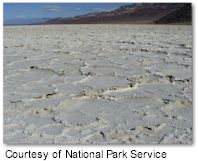|
 Hottest, Driest, Lowest: Death Valley is a land of extremes. It is one of the hottest places on the surface of the Earth with summer temperatures averaging well over 100 degrees Fahrenheit. It encompasses the lowest point in the Western Hemisphere at 282 feet below the level of the sea, and it is the driest place in North America with an average rainfall of only 1.96 inches a year. Hottest, Driest, Lowest: Death Valley is a land of extremes. It is one of the hottest places on the surface of the Earth with summer temperatures averaging well over 100 degrees Fahrenheit. It encompasses the lowest point in the Western Hemisphere at 282 feet below the level of the sea, and it is the driest place in North America with an average rainfall of only 1.96 inches a year.
This valley is also a land of subtle beauties: Morning light creeping across the eroded badlands of Zabriskie Point to strike Manly Beacon, the setting sun and lengthening shadows on the Sand Dunes at Stovepipe Wells, and the colors of myriad wildflowers on the golden hills above Harmony Borax on a warm spring day.
Death Valley is a treasure trove of scientific information about the ancient Earth and about the forces still working to shape our modern world. It is home to plants, animals, and human beings that have adapted themselves to take advantage of its rare and hard won bounty. It is a story of western expansion, wealth, greed, suffering and triumph. Death Valley is a land of extremes, and much more.
Fees:
Vehicle Entrance Fee: $20.00 for 7 days
Individual Entrance Fee: $10.00 for 7 days
Death Valley National Park Annual Pass: $40.00 for one year
Getting There:
Death Valley National Park is transected from east to west by California Highway 190. On the east in Nevada, U.S. Route 95 parallels the park from north to south with connecting highways at Scotty's Junction (State Route 267), Beatty (State Route 374), and Lathrop Wells (State Route 373). South of the park, Interstate 15 passes through Baker, California on its way from Los Angeles to Las Vegas. State Route 127 travels north from Baker to Shoshone and Death Valley Junction with connections to the park on State Route 178 from Shoshone and connection with California Highway 190 at Death Valley Junction.
|



